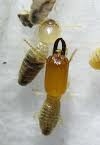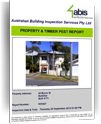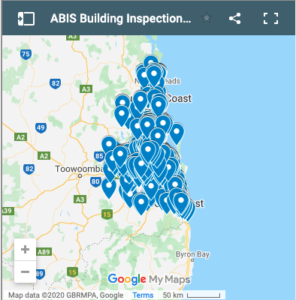Coptotermes Spp.
Coptotermes is widely distributed Australia-wide, except for a few isolated high rainfall areas and is the most destructive species targetting timber buildings. Identification on the basis of soldiers can be unreliable – locality, nesting habits, and measurements can assist identification. Their nests may vary from being completely underground, in an old stump or living tree, in sleeper retaining walls, or in domed mounds. Colonies contain a queen, king, soldiers, workers, and reproductives. Soldiers are 3.5 to 6.5mm, have no teeth on their mandibles and pear-shaped yellowish heads which exude a drop of milky fluid from the frontal gland on the top of their head when disturbed.
Coptotermes acinaciformis: does not build mounds, except in its more northern occurrences. They are central site nesters in tree stumps, living trees, under filled-in verandahs where timber has been buried, and in walls. A tree containing a nest may harbour up to a million termites in the single colony. The nest may be located in the root crown of the tree or in the main trunk up to a height of 3 meters where the trunk is hollowed out in the centre and filled with earth-like material “mud-guts” packed above the nest area.
Via underground tunnels or sealed mud leads, buildings within a radius of 50m may be attacked resulting in extensive undetected damage. It is therefore essential that any trees close to buildings be closely monitored for nests. Soil contact is desirable for these termites, but not essential, provided that there is an assured moisture supply and secure habitat. Although their identification can be difficult, they tend to be more aggressive and less easily disturbed than other species. They form large colonies and are much more likely to produce bivouacs.
Coptotermes frenchi: While the soldiers of this species are smaller (4 to 5.2 mm) than those of Coptotermes acinaciformis, they are found in similar habitats from northern Queensland to South Australia. They are also a central-site nester in the root crown and lower trunk of living trees, and make subterranean tunnels in soil and earthen leads over surfaces. UnlikeCoptotermes acinaciformis, Coptotermes frenchi is very timid and easily disturbed. They form large colonies but rarely produce bivouacs and mudding in their galleries. Coptotermes frenchi tends to be a forest pest attacking living trees and is not as destructive as Coptotermes acinaciformis.


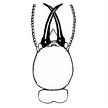
Schedorhinotermes Spp
Schedorhinotermes intermedius: occurs coastally from southern Queensland through to New South Wales. They tend to nest in tree stumps and in the root crown area of living, dead and debilitated trees as well as in timber buried in the ground, under properties, under filled-in verandahs, and in the ground immediately under fireplaces.
This species is typified by two soldier castes: major soldiers with bulbous heads and 5 to 7.5mm and smaller minor soldiers 3 to 5.5mm with narrower heads and more slender mandibles. Both soldier types do not produce the white latex which Coptotermes acinaciformis does.
They are multi-site nesters whose nests may be difficult to locate as they are subterranean. Colonies including a queen, king, soldiers, workers and reproductives may consist of thousands of termites. The minor soldiers appear first in the developing colony, followed by the major soldiers once the nest is well established. Their abundance usually indicates a well-developed and strong colony with increasing potential for damaging timber. This species is second in economic pest status to Coptotermes spp. in most parts of Australia, with their attack taking place under the protection of extensive deposits of fragile “plastering” and excavations are fairly clean with characteristic plaster-like earthen workings separating the termites from the adjacent environment. It is very difficult to evaluate its damage to buildings without a very thorough survey of its activity.
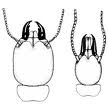
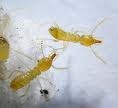
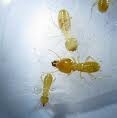

Heterotermes Spp.
Heterotermes ferox: is often encountered attacking posts, poles, paling fences, timber decking and flooring of properties wherever weathering and decay are present. Heterotermes ferox is widely distributed throughout Australia, but fortunately does not range far from its small colonies which include a queen, king, soldiers, workers, and reproductives. Soldiers are 3.5 to 7.5mm and have long rectangular heads with no obvious teeth on their prominent and dark mandibles. Both workers and soldiers have slender bodies, move slowly and the soldiers in particular, are not courageous with their peculiar habit of shuffling backwards when confronted.
Although subterranean, Heterotermes ferox does not build mounds, nor does it have extensive gallery systems, but is a multi-nester with very small colonies in the soil, adjacent to stumps, logs on the ground, rotting wood, or even beside the mounds or nests of other species. Heterotermes ferox liberally plasters over its workings, leaving the surface of affected timber with a mottled appearance. Previously, it was thought to be of very little economic significance; however more recent records have shown that it can cause serious damage to sound timber in service.

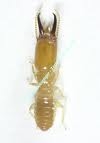
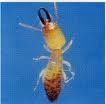
Nasutitermes Spp.
Nasutitermes spp. are multi-site nesters characterised by soldiers with nasute heads tapering to a long snout. Soldiers are smaller and more fragile than workers. In contrast, workers are arched and more heavily built in the front section. They also have two dark areas on the top of the head. Colonies contain a queen, king, soldiers, workers, and reproductives.
Nasutitermes exitiosus: are located in southern Queensland to New South Wales. This is a mound-building species, except in drier areas, where it nests in tree stumps or below ground, often leaving bare earth above it. It is capable of extensively damaging hardwood timber structures specifically attacking wood in the ground and sound wood in buildings. It builds its nests under properties and unless the subfloor area is inspected regularly the colony can go unnoticed until flooring collapses. Wooden bridges, poles and fences are also severely damaged by this species. Their mounds are usually dome shaped, 30 to 75 cm high with a basal diameter of 30-120cm. When the nest is prised up at ground level, there is usually a physogastric queen measuring 25-30mm. Soldiers are generally 3.6 to 4.8mm.
Nasutitermes fumigatus: attacks decaying wood in contact with ground. Where decay has occurred to flooring timbers in a property, due to poor ventilation, these termites will damage the wood, making replacements necessary. They will also attack moist and weathered decking on outside verandahs. However, they do not attack sound structural timbers in well ventilated situations. Their colonies are small and soldiers are generally 3.25 to 3.75 mm.
Nasutitermes walkeri: has the largest soldiers (5 to 7 mm) and is encountered in coastal bushland from Sydney to Cairns, where it constructs characteristic arboreal nests. Colonies appear in the root crowns of trees where there is decay or fire damage. When the colonies are well established and numbers large, they construct arboreal nests higher up the trees but maintain soil contact with galleries extending down the tree trunk. The outside casting of their nest is soft and friable, easily broken and penetrated. The arboreal part of the nest is often connected to another part of the colony in the root crown area or another subterranean part of the tree. Shelter tubes are dark brown to black and often seen on the outside of the tree trunk. Nests are large and populous. Subterranean tunnels just below surface level radiate from the base of the tree to various food sources. Although damage may be done to fences, poles and wood in the ground, attack of buildings is associated with decaying wood and high moisture.
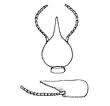


Microcerotermes Spp.
Microcerotermes turneri: are characterised by soldiers which have long rectangular heads are 4.5-5.5 mm in length. Their nests are usually built on the ground, on the trunks of living or dead trees, or on the top of stumps or fence posts. Arboreal nests of this species are found commonly on ironbark trees, for example, the narrow-leaved red ironbark (Eucalyptus crebra). This termite occupies many habitats and has been found in open and moderately dense hardwood forests, grassland, rainforests and vegetated coastal lowlands. The species is very common throughout coastal Queensland South of Cairns and inland to the Carnarvon Range where it attacks hardwood timber in ground contact, such as fence posts.


